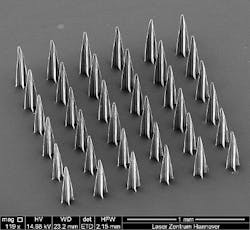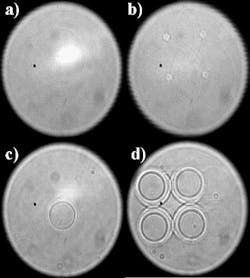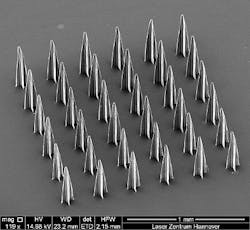Modified laser technique yields faster tissue engineering
| FIGURE 1. This image, taken by a scanning electron microscope, shows 16 micro-Venus structures that were produced simultaneously by a 16-beam two-photon polymerization system. The width of the entire array is less than the diameter of a typical human hair. The 16 structures were produced in approximately 45 seconds. (All images courtesy of Biomedical Optics Express) |
Researchers from the Laser Zentrum Hannover (LZH) eV Institute (Hannover, Germany) and the Joint Department of Biomedical Engineering at the University of North Carolina at Chapel Hill and North Carolina State University (Chapel Hill and Raleigh, NC) have modified an established two-photon polymerization technique to create finely detailed structures such as tissue scaffolds more quickly and efficiently than was previously possible. What's more, their technique could help pave the way to more widespread clinical use of microscale medical devices.
Two-photon polymerization (2PP) creates the tiny tools necessary to manipulate cells and other miniscule structures. In current-generation 2PP technology, a laser pulse that lasts approximately one quadrillionth of a second sends a burst of energy into unset resin, causing the molecules around the pulse to fuse together into two adjoining cone shapes. By focusing on multiple points in succession, 2PP can build up complex 3-D structures, cone-shaped block by cone-shaped block. 2PP can be used to manufacture devices from a wide range of base materials and does not require extreme temperatures, harsh chemicals, or cleanroom facilities, but its main drawback is long fabrication times. But because tissue scaffolds that could mimic natural body parts are large structures, it can take a long time to lay all the pieces together.
Shaun Gittard, one of the research team members of the LZH, notes that many tissues may be large, but they all have important features on the microscale. Using conventional 2PP to manufacture tissue scaffolds for large tissue structures can be prohibitively slow, the team notes; to tackle this problem, they used a computer-controlled hologram to split the 2PP laser into multiple beams, creating up to 16 different focus points that can work simultaneously.
The team notes in their paper an example of fabricating a single-layered, 1 mm square with 100 nm resolution. With conventional single-focus 2PP at 1 mm/s, fabrication time would be 2 hours and 47 minutes. In contrast, with 16 foci this same area could be scanned in merely 10 minutes, they write, noting that many foci make light work.
The team first tested their multiple foci system by creating 16 miniature Venus statues, each so small as to be invisible to the human eye (see Fig. 1). In addition to replicas of classic Greek artwork, the team also used the new technique to manufacture cylindrical tissue scaffolds (see Figs. 2 and 3) and an array of microneedles. Less than a half-millimeter wide, rocket-shaped microneedles can be used to provide painless injections or take blood samples, notes Gittard (see Fig. 4). The microneedles are promising for real-time, pain-free glucose sensing and insulin delivery for treating diabetes, he adds.
The team's next goal is to use the system to produce one large, complex 3-D structure with sub-micron features, which is a more complicated task since it requires moving the relative placement of the different foci during the fabrication process, says Gittard. Many cell features, such as organelles, are on this size scale, and such detailed features could be used to control cell attachment and alignment, which is important since cell orientation affects function in a number of tissues, such as blood vessels, nerves, bone, and muscle, he says.
The team's work is described in a paper published this week in Biomedical Optics Express. For more information, please visit http://www.opticsinfobase.org/boe/abstract.cfm?uri=boe-2-11-3167.
-----
Follow us on Twitter, 'like' us on Facebook, and join our group on LinkedIn
Follow OptoIQ on your iPhone; download the free app here.
Subscribe now to BioOptics World magazine; it's free!



